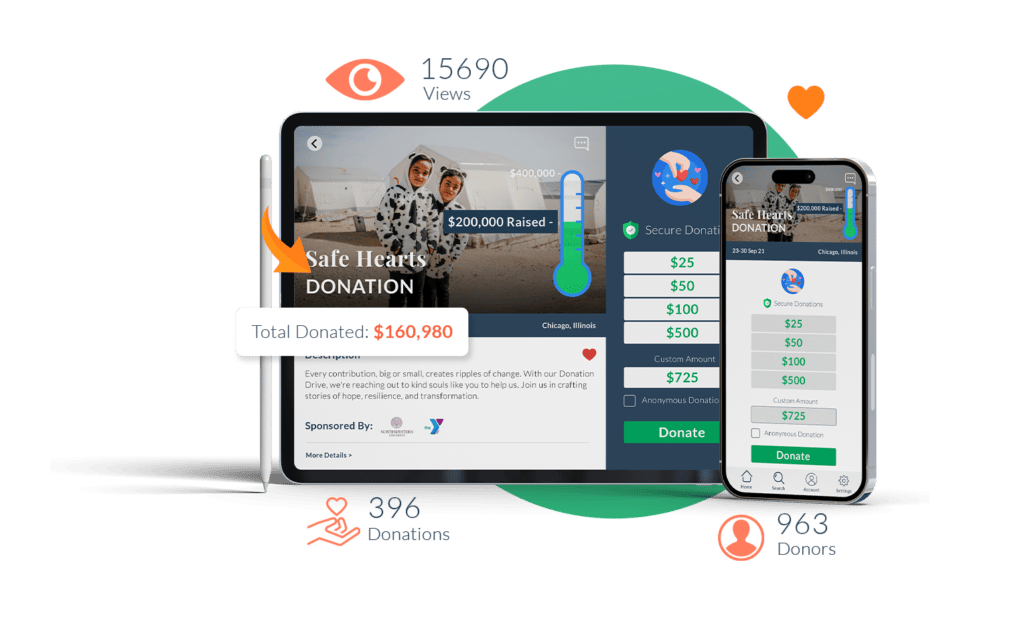
Asking for donations in person can be intimidating, but it is also one of the most effective ways to raise funds for your cause. In-person asks allow you to connect with potential donors on a personal level and make a lasting impression. However, it takes more than just showing up and asking for money to be successful. In this article, we will discuss five effective tips to increase fundraising event attendance and successfully ask for donations in person.
Table of Contents
ToggleWhy In-Person Asks Are Important
In today’s digital age, it may seem easier to send out mass emails or post on social media to ask for donations. While these methods can be effective, they lack the personal touch that in-person asks provide. Meeting with potential donors face-to-face allows you to build a relationship and make a stronger case for your cause. It also shows that you are dedicated and passionate about your cause, which can inspire others to support you.
Tip 1: Plan Ahead
Before you start asking for donations in person, it is essential to have a plan in place. This includes setting a fundraising goal, creating a budget, and identifying potential donors. It is also crucial to have a clear understanding of your cause and how the funds will be used. This will help you make a compelling case when asking for donations.
Especially if you’re a smaller organization just getting started, it might be hard to define your goals beyond “Get money to solve X problem.” But people want to know how their money will be used, and want assurance that it will be used responsibly. Even if you’re still exploring different solutions to the problems you’re trying to solve, you can say that you’re researching the best approach. The money can go towards paying researchers or for a survey.
Have a short explanation of who you are, what your organization hopes to accomplish, and how it plans to get there. This brings us to our next point: practice.
Tip 2: Practice Makes Perfect
Sometimes it’s tempting not to practice pitches or public speaking because we’re worried we’ll sound rehearsed. But people will forgive a little rehearsal as long as you have the information they’re looking for. Here are a few facts and figures you should know cold:
- Practice your elevator pitch: a short sentence or two about your organization and how you plan to achieve your goals.
- Know how much you need to raise for each campaign or initiative, and try to have an idea of how close you are to each goal.
- Have a few examples of stories about how your organization has helped people, animals, the environment, or whatever your cause aims to achieve.
- Practice a few different ways to ask for the money itself. “I’m wondering if you would consider donating $XXX today?” or “Can we count on your support for this program?” etc.
Try to practice with a real person, either a colleague or a friend. Even if this feels silly or embarrassing, they’ll be able to give you valuable feedback. They’ll be able to help you develop your strengths as a fundraiser making pitches.
Tip 3: Make a Connection
When meeting with potential donors, it is essential to make a personal connection. Take the time to get to know them and their interests. This will help you tailor your ask and make it more meaningful. It is also essential to listen to their concerns and address any questions they may have.
It’s not generally a good idea to start a relationship or conversation with your request for money. There might be the odd hard-boiled business giant who wants you to cut to the chase, but in most cases you’ll do better to get to know individuals who have shown an interest in your cause. Try to have conversations with everyone at your events, or at least everyone on your list of potential major donors. Ask what aspects of your organization’s work most appeals to them and why.
Building a relationship with potential donors can lead to long-term support for your cause.
Tip 4: Do Your Research
When asking for donations in person, it is crucial to be prepared. Whether you’re working a crowd at an event or approaching a particular individual, doing some research beforehand is a good idea.
If this individual is a stranger to you, check their LinkedIn profile and any other publicly available information to learn more about their background, career, and perhaps hobbies or interests. You probably won’t bring up much of this information when you speak with them (no need to sound like a stalker), but it will help inform your conversation with them. You may even learn why this person cares, or might care, about your cause.
Try to learn whether this individual has given to your organization in the past: this can help inform the amount you want to ask for. Check to see if they’ve volunteered with your cause, or similar causes in the past. Which of your organization’s events or initiatives have they attended or shown interest in? This will help you figure out what they might be interested in supporting moving forward.
Being prepared will help you make a strong case and increase your chances of receiving a donation.
Tip 5: Tell Stories
One of the most effective ways to make a personal connection and inspire others to donate is through storytelling. Share stories of how your cause has impacted individuals or communities.
This will help potential donors understand the importance of your cause and the impact their donation can make. It is also essential to use visuals, such as photos or videos, to make your stories more impactful.
Tip 6: Follow Up
After meeting with potential donors, it is crucial to follow up with them. This shows that you value their time and are dedicated to your cause. It is also an opportunity to thank them for their time and answer any additional questions they may have. Following up can also lead to additional donations or long-term support for your cause.
Some Advice on Different Types of Fundraising Pitches
There’s a few different scenarios where you might be asking for donations in person. Below we have some tips for each.
Crowd Work
So you planned an amazing event and people came and had fun all in the name of your cause! Besides the price of admission and perhaps an auction you have another opportunity to raise more money. Ask your guests to participate in a lightning round of fundraising: you ask for $20, $50, or $100 increments (depending on your audience). You can have volunteers carry baskets around for cash and even add a paddle raise feature to help keep track of big donations.
Hyping up a crowd to donate more requires high energy and enthusiasm: make sure you explain the impact their money will have on your cause. If the idea of this kind of public speaking gives you hives, consider finding an experienced MC willing to help.
If there’s no one in your connections with this kind of experience, try reaching out to local small theater groups, improv clubs, or any performers you know. They’ll almost certainly be able to point you toward someone willing to help for free or a minimal fee.
Talking Up Individuals at Events
Even if you can’t get up on a stage and get a crowd excited to give more, you can mingle and talk to individuals in the crowd. Take the time to introduce yourself to every table or group and explain what you do for the organization. Ask what brought them to your event: and be prepared for some to say that they simply got a free ticket or came with a partner or parent. It’s okay if they simply came to have a good time!
If you come across a group or individuals that are particularly interested in your cause, explain to them how their gifts can help. Perhaps have a stat ready like, “We have about 250 people here tonight, if even 100 of them each gave $100 we would surpass our goal for the evening.”
While asking for donations is important, it’s just as important to build relationships. You might not remember everyone you talk to in one evening, but hopefully they’ll remember you and your warmth, or humor, or passion, and consider supporting your cause in the future.
Private Meetings
If you’ve set up a meeting with an individual donor you likely already have big hopes for their donation. Donors who provide major gifts like to know that their money will be put to good use responsibly.
Be prepared for your meeting with a number or ballpark for your request. If you need funds for a particular initiative, be ready to explain why it’s important to your cause or to your operations. Have numbers prepared to show, even if you don’t think you’ll need them. Know what this donor has given their money or time to in the past. And don’t beat around the bush: they almost certainly know that you’re interested in meeting with them to make a request.
Final Thoughts
Asking for donations in person can be intimidating, but it is also one of the most effective ways to raise funds for your cause. By planning ahead, making a personal connection, being prepared, using storytelling, and following up, you can increase your chances of receiving donations. We have two final tips for you:
- Be direct: Remember that you don’t have to mince words or apologize for asking for funds that will go towards important works.
- Don’t be discouraged by No: Not everyone will be willing or able to donate to you, even if you ask in person. That’s ok: most “no”s will not be a reflection on you, your manner, or your organization. When you get disappointed, try to direct your energies to other fundraising sources and keep moving forward.
With these tips and ideas, we hope you can successfully ask for donations in person and make a positive impact for your cause.






